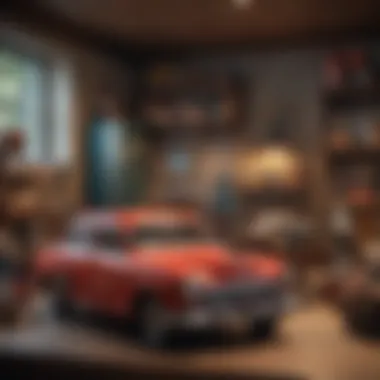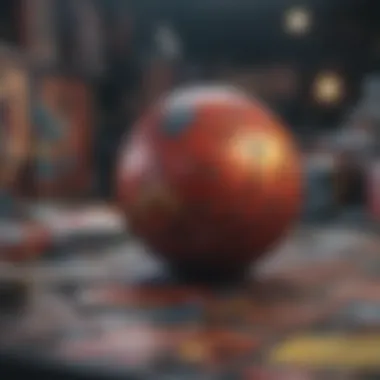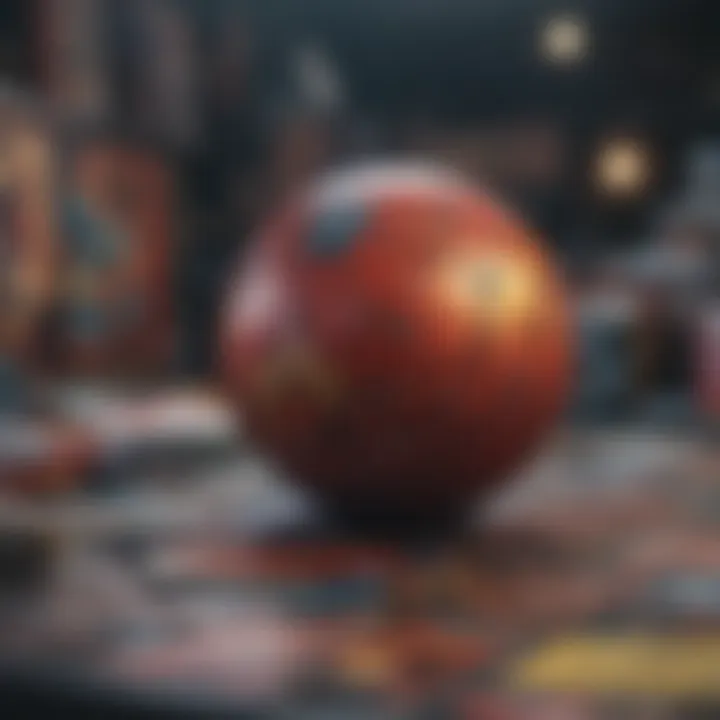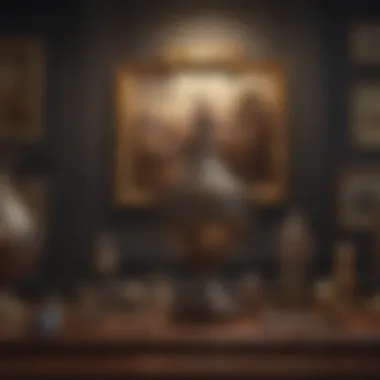Exploring the Value and Passion in Collectibles


Intro
Collectibles are more than just items gathered over time; they represent passions, memories, and a personal journey through history. They capture the essence of particular eras and places, making them tangible pieces of art and nostalgia. For many, starting a collection can be an exhilarating endeavor, while for others, it might feel intimidating. Yet, as you delve into this intricate world, understanding the underlying dynamics becomes crucial. This article will guide you through the diverse realms of collectibles, spotlight the significance of rarity, value, and personal connection, and help you navigate the contemporary landscape where tech meets tradition.
Many collectors often ask themselves, "Why do I collect?" The motivations can vary greatly, from a desire to relive one's childhood to seeking financial gain. The rise of digital and mobile collectibles has also altered the playing field, introducing exciting opportunities alongside significant challenges. And with this shift comes the necessity for knowledge. How do trends develop? What factors drive market prices up or down? These questions aren't just idle musings; they're key to making informed decisions.
From vintage toys to limited-edition sneakers, let’s pull back the curtain on collectibles, allowing both seasoned enthusiasts and newcomers to find common ground and insight. In this guide, we will untangle the knots of collecting, so you know what to keep and what to let go.
Preamble to Collectibles
In the world we navigate today, collectibles represent more than just objects; they symbolize passion, memories, and sometimes, a slice of history. The topic of collectibles is crucial because it opens doors to understanding the intricate relationship people have with their possessions. This article seeks to dive into this captivating realm while highlighting significant elements that inform collectors both new and seasoned.
Defining Collectibles
What exactly qualifies as a collectible? The term can include a vast assortment of items, ranging from vintage comic books and rare coins to modern video game memorabilia. Essentially, collectibles are objects that individuals pursue, often with the intent of enriching their personal spaces or securing their financial future. Items considered collectible vary widely, but they typically share the characteristics of being scarce, desired, and often, imbued with personal or historical significance.
Consider, for instance, the fascination surrounding action figures from the 1980s. Some collectors obsess over original packaging, while others seek to complete a set from their childhood. It’s this intersection of nostalgia and financial savvy that makes the act of collecting so compelling.
As we move forward in this article, keep in mind that the interests of collectors are as diverse as the items themselves. Always consider that what one individual might deem trivial, another may view as a veritable treasure.
A Brief Historical Perspective
Collecting has a long and winding history, tracing back to ancient civilizations where individuals amassed wealth in the form of artifacts, coins, and art. Historically, items like ancient pottery, sculptures, and manuscripts held immense value not only for their craftsmanship but also for the stories they told about their times. Fast forward to the present, and we see similar behaviors mirrored in the rise of pop culture collectibles, where items like Funko Pop figures and limited-edition sneakers can fetch staggering sums.
In the modern era, the accessibility of information via the internet has revolutionized the collecting landscape. Marketplaces such as eBay and social platforms like Facebook enable enthusiasts to connect and transact in ways that were unimaginable in the past. No longer confined to local shops or conventions, collectors can now expand their horizons globally, hunting for that elusive item they believed to be lost to time.
As the world changes, so too do the motivations and methods behind collecting. Each collectible item carries with it a narrative that reflects its era, the culture surrounding it, and the individual journeys of those who seek to possess it. Understanding the historical context not only enriches one’s appreciation of collectibles but also enhances their intrinsic value in the eyes of serious collectors.
The Psychology Behind Collecting
Understanding the psychology behind collecting is crucial when diving into the intricate world of collectibles. The act of gathering items goes beyond mere ownership; it taps into deep-seated aspects of human behavior, identity, and social interactions. Many collectors find that their passions drive them not just to acquire, but also to connect with others who share similar interests. There’s more at stake than just the tangible item; it’s about the stories, emotions, and communities formed around these treasures.
Motivations for Collection
People are motivated to collect for various reasons, and these can broadly be categorized into intrinsic and extrinsic factors. The intrinsic motivations typically arise from personal enjoyment and fulfillment. Collecting provides an opportunity for individuals to express their identity, embrace their hobbies, and indulge in nostalgia. For example, think about someone who collects vintage video games: every console and cartridge reminds them of childhood memories, encapsulating experiences that shaped their formative years.
Extrinsic motivations, on the other hand, often include the social aspects surrounding collecting. Many collectors find joy in showcasing their items, whether that’s through social media, private gatherings, or conventions. These platforms allow them to engage with other enthusiasts, fostering camaraderie and bringing a sense of belonging. Nevertheless, collectors may also seek status and recognition from peers—finding value not just in the collection itself, but in the community built around it.
In simpler terms:
- Personal Expression: Collecting allows individuals to manifest who they are.
- Nostalgia: Older items often evoke specific memories, emotions, and shared experiences.
- Community: Collectors connect around shared interests, creating networks that enhance the collection journey.
- Status: High-value items can confer social recognition.
Emotional Values Attached to Collectibles
The emotional attachment people develop with their collectibles is often what sets this hobby apart from mere consumerism. Each item holds value that might not align with its market price. For instance, a comic book that brings back fond memories of childhood may be deemed priceless by its owner, despite its low resale price. This emotional resonance occurs due to personal history and associations with the items.
Moreover, emotional values can be thought of in several layers:
- Sentimental Connection: Items often bear witness to important life moments—birthdays, achievements, or loved ones—their value can be deeply intertwined with such memories.
- Symbolism: Often collectors imbue their items with meanings that reflect personal beliefs or experiences. A vintage item could symbolize a period in one’s life or mark a triumph over adversity.
- Legacy and Inheritance: Collections often span generations, with family heirlooms passing from one member to another. The emotional weight that comes with maintaining these collections adds an additional layer of significance.
The passion for collecting not only fulfills a desire for gathering but also hits home on emotional levels that help shape one’s identity.
"Collecting is not just about the things we hold; it's about the memories and the meaning those things bring into our lives."
In summary, the psychology behind collecting is a fascinating blend of motivations and emotional connections. Collectors are not merely acquiring objects; they are, in fact, participating in a rich narrative—a story that encompasses their fondest memories, social interactions, and ambitions. This deep-rooted passion is what makes collecting more than just a hobby; it becomes an integral part of one’s life.
Categories of Collectibles
The realm of collectibles is vast and multifaceted, encompassing a delightful mix of interests, historical significance, and personal attachments. Classifying these collectibles into categories helps enthusiasts and casual collectors alike navigate their passions with greater clarity and understanding. Each category presents unique characteristics that can influence the collector’s journey, shaping not just their collections, but also their experiences and the stories behind each item. By delving into categories, one can appreciate the nuances that set apart various kinds of collectibles, as well as the rich history and purpose they hold in the world.
Art and Antiques
Collecting art and antiques stands as one of the most revered practices throughout history. There's a certain prestige associated with owning a piece that echoes centuries past, whether it’s a classic oil painting or a handcrafted piece of furniture. Art has the power to evoke emotions, challenge perceptions, and, ultimately, connect us to our heritage. Collectors often find themselves in a dance between passion and investment when acquiring these pieces.


- Investment Potential: Original works can fetch impressive sums at auctions, enticing collectors to see art not only as a personal treasure but also as a wise financial move.
- Cultural Significance: Items often tell stories of their time, adding layers of cultural appreciation as collectors delve into the periods from which they originate.
However, it's important to be aware of provenance to ensure authenticity. Engaging with this category means having a discerning eye and sometimes a good nose for fakes.
Toys and Games
When it comes to sentimentality, toys and games often steal the show. There's a sense of nostalgia that accompanies these collectibles. Many grew up with Hot Wheels, Barbies, or vintage board games like Monopoly, making this category rich with personal memories.
- Vibrant Community: Collectors often form tight-knit communities, sharing tips and showcasing their finds at conventions and online platforms, such as Reddit.
- Rarity Equals Value: The thrill of discovering a rare action figure in its original packaging offers immense gratification to collectors and can significantly boost its market price.
A well-preserved toy can transport you back to childhood, while offering a fascinating peek into the evolution of design and play over time.
Stamps and Coins
Stamps and coins capture the essence of historical documentation and artistry in a compact form. Currency has always reflected the social, political, and economic climates of its time, while stamps often depict national pride and notable events. Collectors find joy in piecing together narratives through these minute artifacts.
- Global Exploration: Many collectors embark on journeys across countries to find unique or rare selections, educating themselves about different cultures along the way.
- Investment Viability: Certain mint condition coins and rare stamps can appreciate significantly, thus they are often viewed as stable investments.
The experience of holding a coin that dates back centuries or a stamp celebrating a landmark moment in history can create profound connections to the past.
Digital Collectibles
In our fast-paced digital age, collectibles have entered a new dimension. Digital collectibles—like NFTs or in-game assets—are capturing interest in surprising ways. While some might dismiss them as fleeting trends, many collectors see genuine value in this frontier.
- Innovative Ownership: Digital collectibles often operate on blockchain technology, providing a method of confirming ownership and authenticity that traditional items can’t match.
- Access to a Global Marketplace: Platforms like Facebook or specialized sites often host vast communities where enthusiasts buy, sell, and exchange digital assets, broadening options for collectors.
As new technology shapes the landscape of collecting, embracing digital collectibles may be the next step for those looking to diversify their collections beyond physical forms.
"A collector's passion is only limited by their imagination—and in the case of digital items, that imagination can be boundless."
In concluding this survey of collectibles, it’s clear that each category offers not only varied opportunities to indulge personal interests but also unique challenges. Understanding these categories aids collectors in making informed choices, strengthening their affinity for their treasured items, all while fostering deeper connections to history, culture, and community.
The Rise of Mobile Gaming Collectibles
The popularity of mobile gaming collectibles has surged in recent years, marking a significant shift in how people engage with their hobbies. For many gamers, collecting has always been part of the experience. But mobile gaming has introduced new dimensions—with millions of players actively participating in a diverse range of virtual environments. This evolution underscores the importance of understanding digital collectibles, alongside traditional ones, as we navigate today's complex market.
The essence of collecting in mobile gaming reaches beyond mere pixels. It includes the thrill of discovery and the satisfaction that comes with assembling unique collections to showcase personal taste. Furthermore, this avenue caters to a new generation where gaming transitions from a just pastime to a viable investment opportunity. With titles like Axie Infinity or Pokemon GO, players find themselves not only enjoying the gameplay but also participating in a thriving collector's ecosystem.
In this environment, value isn’t just tied to rarity—it’s also about community engagement, cultural relevance, and the emotional ties players form with their collectibles.
Trends in Mobile Gaming Collectibles
One prominent trend is the increased incorporation of non-fungible tokens (NFTs) in mobile gaming. These digital assets enable players to own unique items that can be bought, sold, or traded across platforms. Unlike traditional gaming items that may be bound to a single game, collectibles represented by NFTs can offer players the ability to move their creations from one game universe to another, enhancing their value and utility.
Another trend is the development of in-game economies. Developers are crafting experiences where players can monetize their time and skills. For instance, games like Fortnite and Call of Duty have introduced skins and other collectibles that directly correlate with gameplay, allowing for a unique blend of enjoyment and economic incentive.
Moreover, there's a noticeable shift towards collaboration between developers and collectors. Game companies often engage with their player base to design exclusive, limited-edition items. This collaboration creates a sense of ownership and involvement among players, making their collections feel more personal and significant.
Unique Features of Mobile Collectibles
Mobile collectibles are dynamic and often interactive, making them distinct in the broader collectibles landscape. Unlike static items found in traditional collections, mobile collectibles often have functionalities that enhance gameplay or offer unique visual experiences. For instance, consider how virtual pets or avatars can evolve based on gameplay decisions. These features create an ongoing relationship with the collectible rather than a one-time acquisition.
Another noteworthy attribute is the connectivity inherent in mobile gaming. Players often share their collections on platforms like Reddit or Facebook, facilitating discussions about strategy and value assessments. This community engagement significantly influences how collectibles are valued within the gaming ecosystem. The conversations and exchanges create an online marketplace where the significance of an item can fluctuate rapidly based on player preference and market demand.
Additionally, the accessibility of mobile devices also democratizes collecting. Gamers from various backgrounds can participate without the hefty costs often associated with traditional collectibles like stamps or comics. This inclusivity helps bolster the community, allowing for a vast array of tastes and preferences within the collectible sphere.
Ultimately, the rise of mobile gaming collectibles has woven a rich tapestry, characterized by innovation, community, and a unique interplay of enjoyment and investment. As players navigate this vibrant landscape, staying informed about trends and understanding the nuances of these collectibles can bridge the gap between mere participation and astute collection.
Evaluating Value in Collectibles
Understanding the nuances of value in collectibles is crucial for anyone stepping into this multifaceted world. It is not just about owning items; it’s about recognizing their worth in various contexts. With the ever-growing market for collectibles, evaluating what makes an item valuable goes beyond just price tags and auctions. It involves a thorough comprehension of multiple factors that can enhance or diminish a collectible's significance. For collectors, both novice and experienced, grasping these elements is essential for making informed purchasing decisions and insuring long-term satisfaction in their collecting journeys.
Factors Influencing Worth


When it comes to determining the worth of collectibles, several key factors come into play. The following points highlight some of the most significant:
- Condition: The state of the item can dramatically affect its value. For example, a comic book in mint condition will undoubtedly fetch a higher price compared to one that’s dog-eared and faded.
- Provenance: The history of ownership adds a layer of prestige. A piece that has belonged to a notable individual or has an interesting backstory often commands a premium.
- Market Demand: Trends can shift rapidly. Items that may have been in demand several years ago might lack interest now or vice-versa. Understanding current interests can be invaluable for pricing or buying.
- Age and Scarcity: Older items, especially those in limited supply, tend to be more valuable. A 1950s toy might be worth more than a similar toy from a later decade simply due to its age and the scarcity of remaining pieces.
- Cultural Relevance: Collectibles often reflect societal values or historical events. An item linked to a major cultural phenomenon, like a limited-edition sneaker released alongside a major sports championship, holds higher value because of its cultural resonance.
It’s essential to do comprehensive research and engage with the community when assessing these variables. The dynamic nature of the collectibles market means that an item today could become a hidden gem tomorrow or vice-versa.
Role of Rarity and Demand
Rarity and demand are often seen as two sides of the same coin when it comes to valuing collectibles. Simply put, without demand, rarity alone does not guarantee worth. Let’s break down each factor:
- Rarity: This is straightforward; the fewer are available, the more likely it is that prices will increase, assuming there is demand. For instance, a limited run of vinyl records might become highly sought after if only a handful were produced and the artist gains popularity, therefore driving up prices based on scarcity.
- Demand: Often, what's in vogue will dictate the willingness of buyers to pay higher prices. For example, during the Pokémon trading card boom, certain cards skyrocketed in value due to massive interest from both children and adults alike.
"Collectible value is driven by a delicate balance of rarity and demand; without interest in what is scarce, the item may be less valuable than expected."
For a collector, navigating these waters can sometimes feel like walking a tightrope. One must keep a finger on the pulse of the market while being aware not just of one’s personal interests, but also of what's gaining traction among the broader collecting community.
In summary, evaluating the value of collectibles requires an understanding of multiple interconnected factors. Condition, provenance, market trends, rarity, and demand all contribute to determining worth. Collectors who are adept at reading these signs will find themselves not only enjoying their hobby more fully but also potentially making smarter investments.
Navigating the Collectibles Market
Understanding the collectibles market is crucial for anyone engaged in the hobby—whether a seasoned collector or just starting out. The landscape can seem daunting, with variances in value, authenticity concerns, and the rapid ascension of trends making it imperative to be informed. Navigating through this market is not just about flipping items for profit; it's, more importantly, about appreciating the story behind each piece and what it represents. This section will illuminate how buyers and sellers can thrive in this space by thoroughly understanding two pivotal aspects: buying vs. selling collectibles and understanding market trends.
Buying vs. Selling Collectibles
Deciding to buy or sell collectibles often reflects both emotional ties and strategic decisions. When buying, collectors should adopt a methodical approach. Research is non-negotiable. Auctions, estate sales, and online platforms are just a few venues where one can acquire unique items. Particularly, the importance of varied sources becomes apparent when considering the authenticity and price.
For example, attending local flea markets can reveal hidden treasures that aren’t found in mainstream online stores. While the allure of a bargain is tempting, hesitation at the point of purchase might save one from future regret. Here are a few tips for buyers:
- Study the item’s background: Make a habit of checking provenance or history to understand its journey and significance.
- Evaluate condition: An item’s wear and tear can substantially affect its value. Look closely, and don’t shy away from asking questions.
- Trust your network: Fellow collectors can provide insights that you might not find in a single source. Building relationships can open doors to opportunities and knowledge.
On the flip side of the coin, selling collectibles presents its own challenges. Articulating the value of an item goes beyond just the price tag. Sellers need to establish a rapport with buyers while maintaining transparency. Consider crafting a detailed description emphasizing the item’s unique features and history. Points to consider when selling include:
- Choosing the right platform: Based on your item type, certain sites might suit better. For instance, eBay may be ideal for toys while Heritage Auctions is great for high-end art.
- Timing your sale: The market can fluctuate. Being aware of seasons or events related to the collectible can impact demand.
- Setting realistic expectations: It’s natural to want top dollar for an item, but understanding market trends will guide your pricing strategy.
Understanding Market Trends
Knowledge of market trends is an essential skill for any collector. The collectibles arena is heavily influenced by timing, culture, and external factors. Trends can shift drastically; for instance, one moment Pokémon cards might dominate, then the next, vintage vinyl records could be all the rage. To navigate the waters effectively, consider employing a few strategies:
- Follow industry news: Websites such as Reddit and art or collectibles forums often discuss emerging trends that can impact the market. Joining these discussions can keep you informed.
- Social media monitoring: Platforms like Facebook can serve as both marketplace and community. Observing what items are gaining traction can give insiders’ knowledge about potential up-and-comers in the market.
- Utilize analytics tools: Various websites and tools provide market analytics and sales data that can help gauge trends before they hit the mainstream. Keeping tabs on these can provide you with a leg up on decisions.
"To stay relevant in the collectibles market, one must blend passion with strategy—nurturing one’s enthusiasm while being informed."
Effective navigation of the collectibles market is about balancing personal interest with market realities. Whether choosing to buy or sell, understanding what drives value can empower collectors. By actively engaging in knowledgeable communities and doing rigorous research, one can embrace the rewarding journey within the ever-changing world of collectibles.
Collecting as a Community Experience
Collecting is not merely an individual pursuit; it often transforms into a shared adventure among like-minded enthusiasts. The landscape of collectibles encompasses various niches, drawing individuals into a tapestry woven with stories, experiences, and shared passions. The community aspect of collecting enriches the hobby, adding layers of meaning and connections that transcend the simple act of accumulation.
Networking with Fellow Collectors
Connecting with fellow collectors can offer a wealth of insight and camaraderie. Engaging with others who share the same enthusiasm creates opportunities to exchange knowledge, tips, and resources that can elevate one's collecting experience. Whether discussing the latest trends or helping each other authenticate rare items, these interactions can deepen appreciation for the hobby.
- Benefits of Networking:
- Shared Knowledge: Learning from others who have walked the same path can significantly enhance your expertise.
- Supportive Environment: Collecting can sometimes feel isolating; being part of a community alleviates that loneliness.
- Collaborative Opportunities: Joining forces with fellow collectors can lead to joint ventures in finding or trading valued pieces.
Participating in online platforms like reddit.com or local clubs provides possibilities for establishing meaningful connections.
Participating in Auctions and Conventions
Getting involved in auctions and conventions is another practical outlet for collectors. These events serve as vibrant marketplaces where passion meets opportunity. The excitement of bidding on a long-desired item or stumbling upon a hidden gem can be a thrill only matched by the satisfaction of completing a collection.
Attending auctions and conventions offers numerous advantages:


- Diverse Selection: Auction houses often showcase many collectible items you might not encounter elsewhere.
- Networking Opportunities: These gatherings present chances to meet fellow collectors and industry professionals, fostering connections and collaboration.
- Learning Experiences: Often, conventions host talks and workshops, where experts share their wisdom, providing tips on collecting, valuing items, and recognizing fakes.
"Collecting is not just about owning items; it’s about the journey and the connections you make along the way."
While the thrill of the chase is part of the allure, the relationships formed in the process are often what makes collecting truly fulfilling. In a fast-paced world, the shared experiences and stories are what make the community enduring and vibrant.
Challenges in Collecting
Collecting can be an exhilarating pursuit filled with wonder and nostalgia. However, like any passion, it comes with its set of hurdles. Recognizing these challenges is essential to navigate the often murky waters of the collectibles market. By understanding what lies ahead, collectors can safeguard their investments and enhance their enjoyment of collecting.
Counterfeits and Authenticity
One of the biggest irritants in the collecting world is the ever-present threat of counterfeits. With valuable items at stake, forgers have become increasingly sophisticated in their methods. Imagine coming home, stone-cold certain that you’ve just acquired a rare vintage toy, only to discover it’s a phony when you dig deeper. The heartache is real, and so are the financial implications.
Here are a few pointers on ensuring authenticity:
- Research Provenance: Always look into an item’s history. Understanding where it’s been before can tell you a lot about its legitimacy.
- Due Diligence: Consult experts or trusted sources. Websites like Wikipedia can provide relevant history on common collectibles and notorious fakes.
- Owner Verification: Documents like purchase receipts, certificates of authenticity, or even appraisals can bolster a collector’s confidence in their purchase.
"A collector without a keen eye for detail runs the risk of spending their hard-earned dough on mere illusions of value."
Additionally, the shift toward digital collectibles has opened a whole new can of worms regarding authenticity. While blockchain technology seeks to assure ownership and authenticity in the digital realm, the absence of universal standards leaves many questions unanswered.
Economic Fluctuations
The economy and collecting are intertwined more than many collectors realize. Items that once commanded steep prices can plummet in value overnight due to shifts in economic conditions or trends. For instance, consider how vibrant the Funko Pop culture was a few years back. Prices were skyrocketing, and collectors were lining up outside stores for the next drop. But as interest waned, many collectors found themselves staring at shelves full of pops that were worth a fraction of their original price.
Understanding how economic factors influence collecting requires vigilance and adaptability. Here are some aspects worth considering:
- Market Trends: Keep an eye on news and reports about economic conditions. Shifts in consumer behavior can directly impact collectible values. Websites like Britannica provide sound economic principles that can help gauge worth fluctuations.
- Adapt Strategies: Be prepared to adapt your collecting habits. When economic times get tough, it might be wise to shift from high-value collectibles to more affordable items that still provide joy and satisfaction.
- Engagement with Communities: Platforms like reddit and facebook have vibrant collector communities that share insights on market trends, giving you the edge in spotting upcoming shifts.
The Future of Collecting
The future of collecting is a compelling topic that beckons both seasoned hobbyists and new enthusiasts to consider the inevitable shifts in this vibrant ecosystem. Collectibles are often thought of as tangible items steeped in personal history, nostalgia, and value. However, as technology advances and societal preferences shift, the landscape of collecting is evolving in ways that are both exciting and daunting. Understanding this future helps collectors not just keep pace with trends, but also make informed decisions, ensuring their collections remain both meaningful and financially sound.
Technological Innovations in Collecting
Technological advancements have dramatically reshaped the collectibles market. One standout example is the rise of blockchain technology, which has sparked a revolution in how we authenticate and trade items. As ownership is recorded securely and transparently, collectors can avoid the heartache of purchasing counterfeit memorabilia. Digital collectibles, often referred to as NFTs (non-fungible tokens), allow virtual ownership of art, music, and other media.
Moreover, augmented and virtual reality are making waves. Imagine donning a headset and stepping into a digital museum where your collectibles hang in a virtual gallery. This technology expands how collectors display and share their treasures, bridging the gap between the physical and digital realms. From remote auctions to online marketplaces, tech makes obtaining, trading, and appreciating collectibles easier than ever.
"Technology is not only changing how we buy and sell; it’s transforming how we connect with our collections."
Shifting Trends in Collector Preferences
As we look towards the future, it’s essential to acknowledge shifting preferences among collectors. No longer does the value of collectibles rest solely on rarity or historical significance. Younger generations are gravitating towards items that resonate with their identities—whether it be limited-edition sneakers, gaming memorabilia, or retro toys. This trend is amplified by social media platforms where collections can be showcased, curated, and even monetized.
Additionally, sustainable and ethical collecting is beginning to take center stage. More enthusiasts are considering the environmental impact of their collectibles, seeking items produced responsibly. This new perspective may entice collectors to shop from local artisans or companies that prioritize sustainability, enriching the market with diverse and meaningful choices.
To conclude, the future of collecting is intertwined with the progress of technology and the evolution of personal taste. Embracing these changes allows collectors not only to safeguard their investments but to also enrich their passion for collecting, making it a dynamic and vital part of their lives.
Epilogue
As we wrap up our exploration of collectibles, it's important to recognize the rich tapestry they weave through our lives. Collecting is not merely about acquiring items; it's a journey that intertwines passion, nostalgia, and personal expression. For enthusiasts, each piece represents a chapter of history or a fragment of identity, whether it's an antique that echoes days gone by or a digital collectible that reflects modern innovation.
Reflecting on the Collecting Journey
When you take a step back and reflect on your own collecting journey, consider what drives your passion. Is it the thrill of the hunt or the satisfaction of curating a unique collection? For many, every collectible tells a story, evoking memories of the times and experiences that led to its acquisition. Maybe you stumbled upon a rare comic book at a flea market or inherited a beloved toy from childhood—these moments add to the narrative of your collection.
Take a look at your display. Each item isn’t just a thing; it’s a conversation starter, a piece of art, or a slice of culture. Embrace this relationship and keep in mind that successful collecting isn't gauged solely by value; it's also about satisfaction and personal connection. This self-reflection promotes a deeper understanding of why we collect and ultimately strengthens our relationship with our collections.
Encouraging Thoughtful Collecting Practices
Moving forward, it's essential to adopt thoughtful collecting practices. This transcends simply buying what catches your eye.
- Research Before You Invest: Know what you're getting into. Whether it's vintage toys or high-value art, understanding the market trends and historical significance makes a difference.
- Prioritize Authenticity: Always seek ways to verify authenticity, whether through certifications, reputable dealers, or community insights. Counterfeit culture can be a pitfall that an informed collector can easily navigate.
- Nurture Community Connections: Engaging with fellow collectors enhances your appreciation for your collection. Joining forums or attending conventions can connect you with others who share your passion.
Remember, thoughtful collecting keeps the joy alive. Seek balance between expanding your collection and nurturing your passion. In the end, what matters is the journey, the people you meet along the way, and the memories you create through your collecting venture.
"A collector's journey is not just about the chase; it's about the connections made and stories told along the way."
By honing in on these practices, collectors of all ages can cultivate a rich, sustainable hobby that brings joy and adds meaning to their lives. In the world of collectibles, the value is far more than just monetary; it’s a passion that fuels creativity and community.



